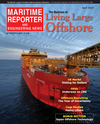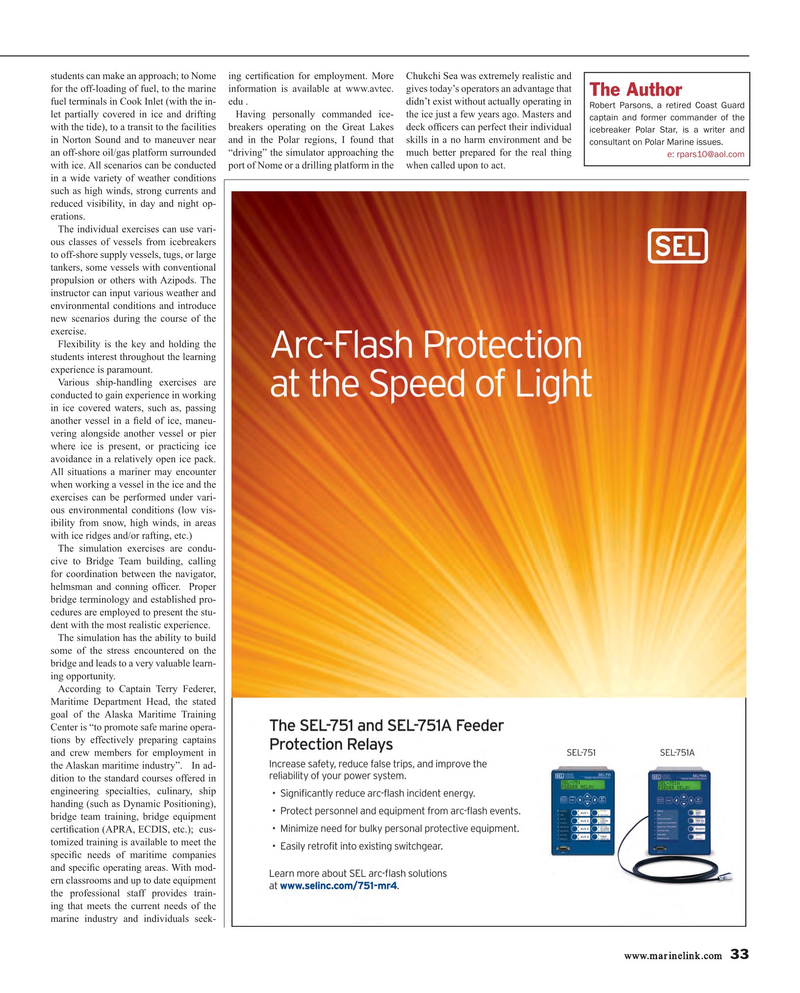
Page 33: of Maritime Reporter Magazine (April 2015)
Offshore Edition
Read this page in Pdf, Flash or Html5 edition of April 2015 Maritime Reporter Magazine
students can make an approach; to Nome ing certi? cation for employment. More Chukchi Sea was extremely realistic and for the off-loading of fuel, to the marine information is available at www.avtec. gives today’s operators an advantage that
The Author fuel terminals in Cook Inlet (with the in- edu . didn’t exist without actually operating in
Robert Parsons, a retired Coast Guard let partially covered in ice and drifting Having personally commanded ice- the ice just a few years ago. Masters and captain and former commander of the with the tide), to a transit to the facilities breakers operating on the Great Lakes deck of? cers can perfect their individual icebreaker Polar Star, is a writer and in Norton Sound and to maneuver near and in the Polar regions, I found that skills in a no harm environment and be consultant on Polar Marine issues.
an off-shore oil/gas platform surrounded “driving” the simulator approaching the much better prepared for the real thing e: [email protected] with ice. All scenarios can be conducted port of Nome or a drilling platform in the when called upon to act.
in a wide variety of weather conditions such as high winds, strong currents and reduced visibility, in day and night op- erations.
The individual exercises can use vari- ous classes of vessels from icebreakers to off-shore supply vessels, tugs, or large tankers, some vessels with conventional propulsion or others with Azipods. The instructor can input various weather and environmental conditions and introduce new scenarios during the course of the exercise.
Flexibility is the key and holding the students interest throughout the learning experience is paramount.
Various ship-handling exercises are conducted to gain experience in working in ice covered waters, such as, passing another vessel in a ? eld of ice, maneu- vering alongside another vessel or pier where ice is present, or practicing ice avoidance in a relatively open ice pack.
All situations a mariner may encounter when working a vessel in the ice and the exercises can be performed under vari- ous environmental conditions (low vis- ibility from snow, high winds, in areas with ice ridges and/or rafting, etc.)
The simulation exercises are condu- cive to Bridge Team building, calling for coordination between the navigator, helmsman and conning of? cer. Proper bridge terminology and established pro- cedures are employed to present the stu- dent with the most realistic experience.
The simulation has the ability to build some of the stress encountered on the bridge and leads to a very valuable learn- ing opportunity.
According to Captain Terry Federer,
Maritime Department Head, the stated goal of the Alaska Maritime Training
Center is “to promote safe marine opera- tions by effectively preparing captains and crew members for employment in the Alaskan maritime industry”. In ad- dition to the standard courses offered in engineering specialties, culinary, ship handing (such as Dynamic Positioning), bridge team training, bridge equipment certi? cation (APRA, ECDIS, etc.); cus- tomized training is available to meet the speci? c needs of maritime companies and speci? c operating areas. With mod- ern classrooms and up to date equipment the professional staff provides train- ing that meets the current needs of the marine industry and individuals seek- www.marinelink.com 33
MR #4 (26-33).indd 33 MR #4 (26-33).indd 33 4/2/2015 10:02:54 PM4/2/2015 10:02:54 PM

 32
32

 34
34
